Pablo Soldati
Practical Policy Distillation for Reinforcement Learning in Radio Access Networks
Nov 09, 2025

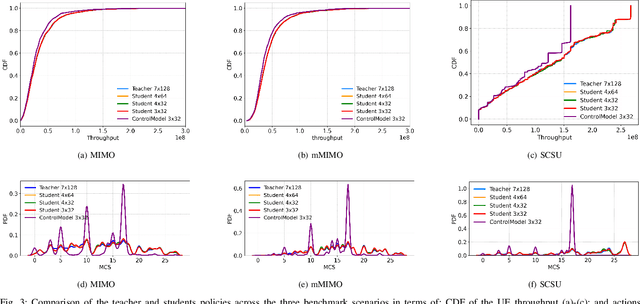
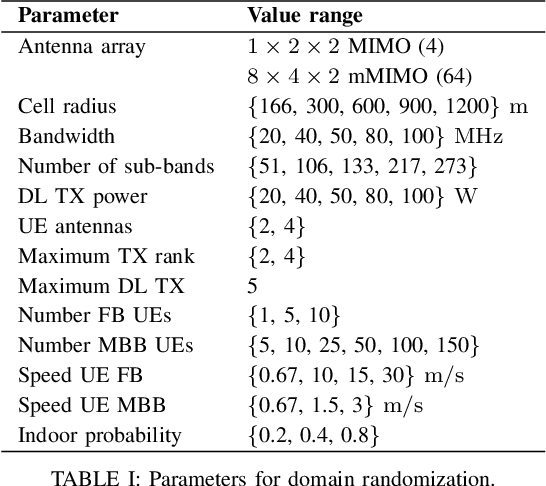
Abstract:Adopting artificial intelligence (AI) in radio access networks (RANs) presents several challenges, including limited availability of link-level measurements (e.g., CQI reports), stringent real-time processing constraints (e.g., sub-1 ms per TTI), and network heterogeneity (different spectrum bands, cell types, and vendor equipment). A critical yet often overlooked barrier lies in the computational and memory limitations of RAN baseband hardware, particularly in legacy 4th Generation (4G) systems, which typically lack on-chip neural accelerators. As a result, only lightweight AI models (under 1 Mb and sub-100~μs inference time) can be effectively deployed, limiting both their performance and applicability. However, achieving strong generalization across diverse network conditions often requires large-scale models with substantial resource demands. To address this trade-off, this paper investigates policy distillation in the context of a reinforcement learning-based link adaptation task. We explore two strategies: single-policy distillation, where a scenario-agnostic teacher model is compressed into one generalized student model; and multi-policy distillation, where multiple scenario-specific teachers are consolidated into a single generalist student. Experimental evaluations in a high-fidelity, 5th Generation (5G)-compliant simulator demonstrate that both strategies produce compact student models that preserve the teachers' generalization capabilities while complying with the computational and memory limitations of existing RAN hardware.
Generalization in Reinforcement Learning for Radio Access Networks
Jul 09, 2025Abstract:Modern RAN operate in highly dynamic and heterogeneous environments, where hand-tuned, rule-based RRM algorithms often underperform. While RL can surpass such heuristics in constrained settings, the diversity of deployments and unpredictable radio conditions introduce major generalization challenges. Data-driven policies frequently overfit to training conditions, degrading performance in unseen scenarios. To address this, we propose a generalization-centered RL framework for RAN control that: (i) encodes cell topology and node attributes via attention-based graph representations; (ii) applies domain randomization to broaden the training distribution; and (iii) distributes data generation across multiple actors while centralizing training in a cloud-compatible architecture aligned with O-RAN principles. Although generalization increases computational and data-management complexity, our distributed design mitigates this by scaling data collection and training across diverse network conditions. Applied to downlink link adaptation in five 5G benchmarks, our policy improves average throughput and spectral efficiency by ~10% over an OLLA baseline (10% BLER target) in full-buffer MIMO/mMIMO and by >20% under high mobility. It matches specialized RL in full-buffer traffic and achieves up to 4- and 2-fold gains in eMBB and mixed-traffic benchmarks, respectively. In nine-cell deployments, GAT models offer 30% higher throughput over MLP baselines. These results, combined with our scalable architecture, offer a path toward AI-native 6G RAN using a single, generalizable RL agent.
Offline Reinforcement Learning and Sequence Modeling for Downlink Link Adaptation
Oct 30, 2024Abstract:Contemporary radio access networks employ link adaption (LA) algorithms to optimize the modulation and coding schemes to adapt to the prevailing propagation conditions and are near-optimal in terms of the achieved spectral efficiency. LA is a challenging task in the presence of mobility, fast fading, and imperfect channel quality information and limited knowledge of the receiver characteristics at the transmitter, which render model-based LA algorithms complex and suboptimal. Model-based LA is especially difficult as connected user equipment devices become increasingly heterogeneous in terms of receiver capabilities, antenna configurations and hardware characteristics. Recognizing these difficulties, previous works have proposed reinforcement learning (RL) for LA, which faces deployment difficulties due to their potential negative impacts on live performance. To address this challenge, this paper considers offline RL to learn LA policies from data acquired in live networks with minimal or no intrusive effects on the network operation. We propose three LA designs based on batch-constrained deep Q-learning, conservative Q-learning, and decision transformers, showing that offline RL algorithms can achieve performance of state-of-the-art online RL methods when data is collected with a proper behavioral policy.
Design Principles for Generalization and Scalability of AI in Communication Systems
Jun 09, 2023



Abstract:Artificial intelligence (AI) has emerged as a powerful tool for addressing complex and dynamic tasks in communication systems, where traditional rule-based algorithms often struggle. However, most AI applications to networking tasks are designed and trained for specific, limited conditions, hindering the algorithms from learning and adapting to generic situations, such as those met across radio access networks (RAN). This paper proposes design principles for sustainable and scalable AI integration in communication systems, focusing on creating AI algorithms that can generalize across network environments, intents, and control tasks. This approach enables a limited number of AI-driven RAN functions to tackle larger problems, improve system performance, and simplify lifecycle management. To achieve sustainability and automation, we introduce a scalable learning architecture that supports all deployed AI applications in the system. This architecture separates centralized learning functionalities from distributed actuation and inference functions, enabling efficient data collection and management, computational and storage resources optimization, and cost reduction. We illustrate these concepts by designing a generalized link adaptation algorithm, demonstrating the benefits of our proposed approach.
Decentralized Joint Beamforming, User Scheduling and QoS Management in 5G and Beyond Systems
Feb 23, 2021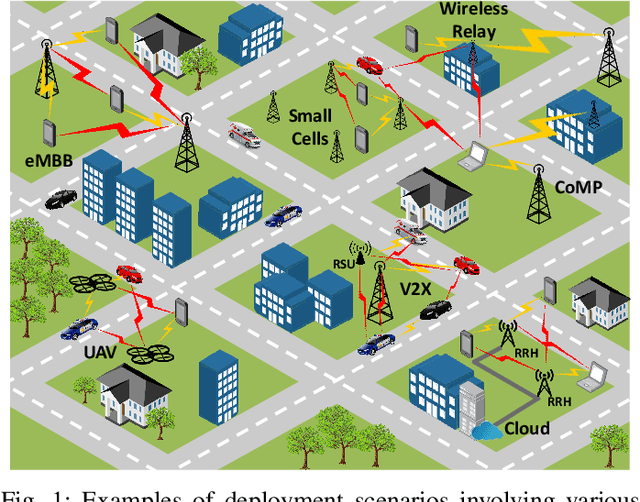
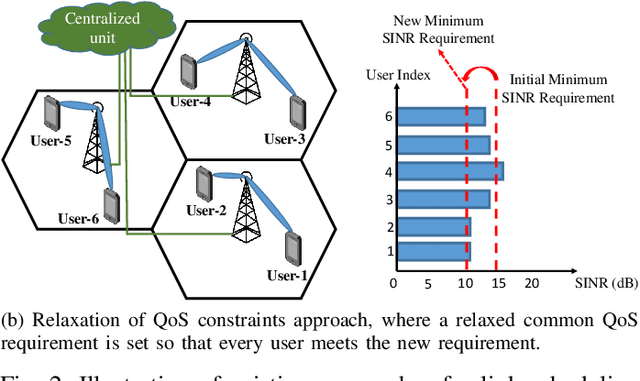
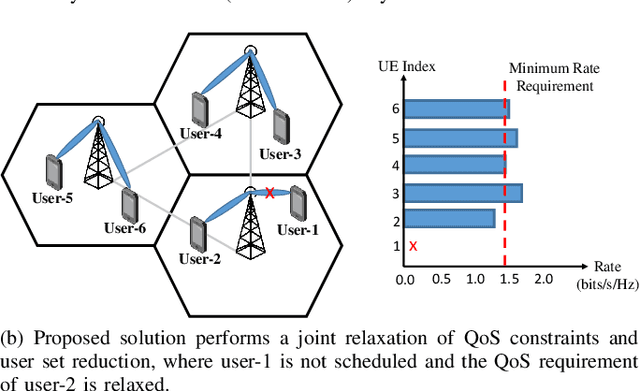
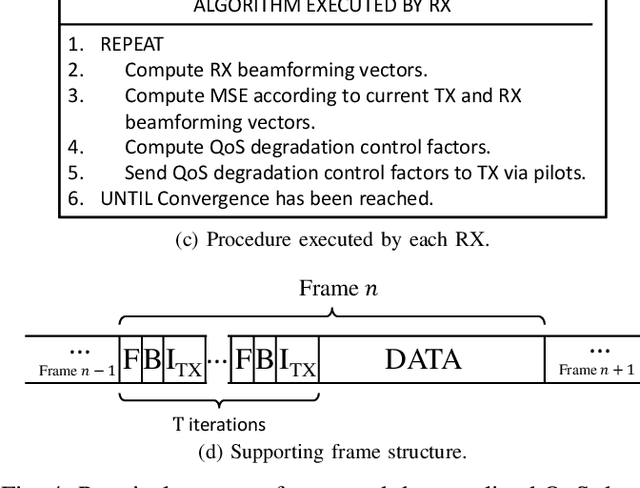
Abstract:Fifth generation cellular systems support a broad range of services, including mobile broadband, critical and massive Internet of Things and are used in a variety of scenarios. In many of these scenarios, the main challenge is maintaining high throughput and ensuring proper quality of service (QoS) in irregular topologies. In multiple input multiple output systems, this challenge translates to designing linear transmit and receive beamformers that maximize the system throughput and manage QoS constraints. In this paper, we argue that this basic design task in 5G and beyond systems must be extended such that beamforming design and user scheduling are managed jointly. Specifically, we propose a fully decentralized joint beamforming design and user scheduling algorithm that manages QoS. A novel feature of this scheme is its ability to reduce the initial rate requirements in case of infeasibility. By means of simulations that model contemporary 5G scenarios, we show that the proposed decentralized scheme outperforms benchmarking algorithms that do not support minimum rate requirements and previously proposed algorithms that support QoS requirements.
 Add to Chrome
Add to Chrome Add to Firefox
Add to Firefox Add to Edge
Add to Edge